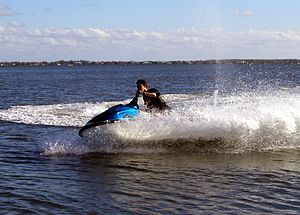- Clayton Jacobson II
-
Clayton Jacobson II (born 1932 or 1933[1]) is credited with inventing the personal water craft, including both the sit-down and stand-up models.[2][3]
 Pump-jet PWCs such as this Yamaha Waverunner are extremely popular for their speed and maneuverability.
Pump-jet PWCs such as this Yamaha Waverunner are extremely popular for their speed and maneuverability.
Early design and prototypes
Jacobson was a banker from Arizona and dirt bike rider who looked to translate his hobby to water. Though he enjoyed dirt bike racing as a form of stress relief, he hoped bringing it to water would do away with the hard crashes. The original idea was designed in the mid-1960s, powered by an internal pump-jet rather than an outboard motor,[3] made of all aluminum, and had a fixed, upright handle. Jacobson eventually quit his job in banking to devote himself to developing the idea, and had a working prototype by 1965. It differed slightly from modern personal watercraft but had definite similarities. He completed a second prototype a year later made of fiberglass.[4]
In 1967 he was approached by the Bombardier Corporation, which manufactured the Ski-Doo snowmobile. He developed a sit-down craft known as the Sea-Doo, which went on sale in 1968. The design had a round hull as opposed to the more conventional V-shaped hull, strakes, a very narrow body, and a high length-to-beam ratio. The model has since come to be referred to as the turtle, perhaps from the appearance of the overturned hull in the water. However the design suffered from some problems, as it was reportedly underpowered and rather unwieldy with its rounded hull. The original model contained an 18 hp (13 kW), 318 cc Rotax, air-cooled engine, though the design may have suffered from mechanical problems and poor components and materials. Bombardier's main focus at this time was on the larger snowmobile market, and the Sea-Doo only saw a limited production between 1968 and 1970. The product was dropped shortly after and the rights to the invention then reverted to Jacobson in 1971.[2]
Later developments
Though he continued to refine the idea, Jacobson could not make an agreement with another manufacturer until the end of the exclusive license with Bombardier in 1971. The day after it expired he went into a partnership with Kawasaki and sold off his patent rights to them. He developed a stand-up personal watercraft, similar to his original concept design, for Kawasaki branded the Jet Ski. The difference was that it featured a collapsible vertical pole which swung down onto the deck of the craft. The design was meant to be for a more personal craft, and had room for only one person.[2] Jacobson and Kawasaki created six different prototypes in 1972, before bringing two to market in 1973, the WSAA and the WSAB.[4] He later alleged in court that Kawasaki terminated the agreement and told him his patents were not needed. He filed suit against them in 1976, and settled in 1979. Kawasaki nevertheless remained the exclusive manufacturer of PWCs until Jacobson made a licensing agreement with Yamaha in 1986.[5] With the success of the Jet Ski, Bombardier relaunched the Sea-Doo in 1988.[3] Up till 1991, Jacobson earned about US$3 million in royalties on the PWC over the years.[1]
Jacobson filed another lawsuit against Kawasaki and two of its American subsidiaries in 1989, claiming they had improperly obtained patents for the Jet Ski in Japan and named its own employees as the inventors. The former claims were dismissed by the judge, but on the latter Jacobson was awarded US$7.5 million in compensatory damages and US$13.5 million in punitive damages by a jury in July 1991 for libel and slander. However the ruling was overturned by a US judge in September of the same year, stating evidence was insufficient and ordered for a new trial.[5] The two sides reached a settlement in August 1992. No payment amounts were disclosed, but Kawasaki Motors Corp. U.S.A. agreed to acknowledge Jacobson invented the Jet Ski, and all charges against Kawasaki were dropped.[6]
References
- ^ a b Unknown author (1991-07-10). "Kawasaki Heavy Industries to Pay Inventor in Libel Suit". Wall Street Journal. p. A6.
- ^ a b c Sampsell, Michael M.; et al. (2002). Boat Accident Reconstruction and Litigation. Lawyers & Judges Publishing. pp. 63–4. ISBN 0913875791.
- ^ a b c Action, Johnny; Adams, Tania; Packer, Matt (2006). Origin of Everyday Things. Sterling Publishing. pp. 124. ISBN 1402743025.
- ^ a b "Jet Ski Evolution". boats.com. http://www.boats.com/news-reviews/article/jet-ski-evolution. Retrieved 2007-09-11.
- ^ a b Unknown author (1991-09-17). "Judge Orders New Trial in Kawasaki Jet Ski Case". Wall Street Journal. p. C11.
- ^ Unknown author (1992-08-17). "Kawasaki Heavy Industries Ltd.: U.S. Unit, Inventor Reach Settlement in Legal Dispute". Wall Street Journal. p. B6.
Categories:- 1930s births
- People from Arizona
- American inventors
- Living people
Wikimedia Foundation. 2010.
